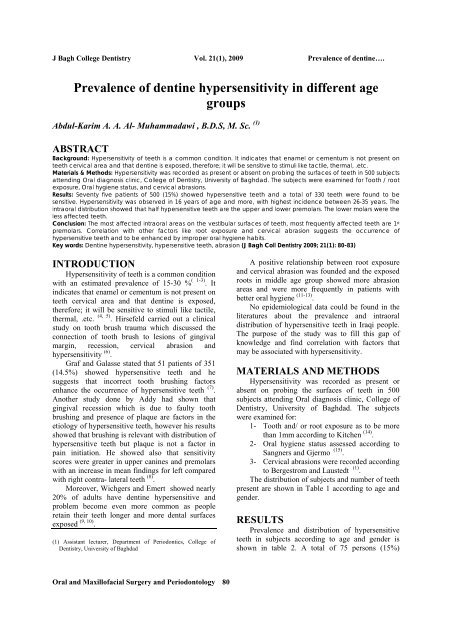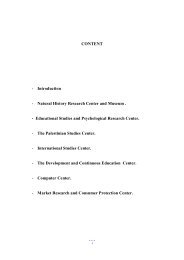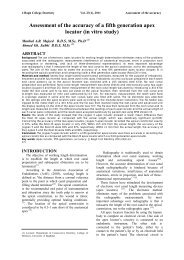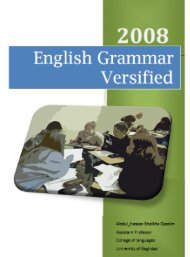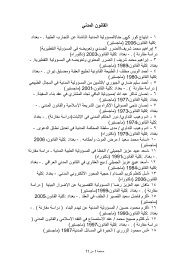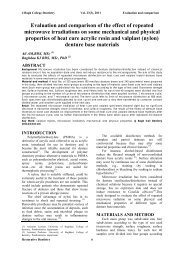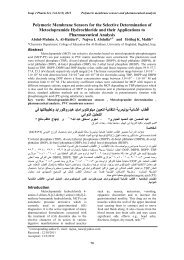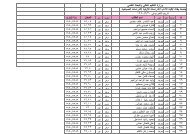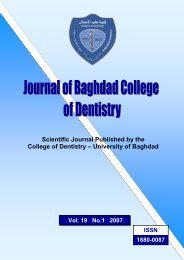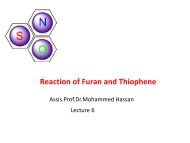Vol 21 No. 1
Vol 21 No. 1
Vol 21 No. 1
Create successful ePaper yourself
Turn your PDF publications into a flip-book with our unique Google optimized e-Paper software.
J Bagh College Dentistry <strong>Vol</strong>. <strong>21</strong>(1), 2009 Prevalence of dentine….<br />
Prevalence of dentine hypersensitivity in different age<br />
groups<br />
Abdul-Karim A. A. Al- Muhammadawi , B.D.S, M. Sc. (1)<br />
ABSTRACT<br />
Background: Hypersensitivity of teeth is a common condition. It indicates that enamel or cementum is not present on<br />
teeth cervical area and that dentine is exposed, therefore; it will be sensitive to stimuli like tactile, thermal, .etc.<br />
Materials & Methods: Hypersensitivity was recorded as present or absent on probing the surfaces of teeth in 500 subjects<br />
attending Oral diagnosis clinic, College of Dentistry, University of Baghdad. The subjects were examined for Tooth / root<br />
exposure, Oral hygiene status, and cervical abrasions.<br />
Results: Seventy five patients of 500 (15%) showed hypersensitive teeth and a total of 330 teeth were found to be<br />
sensitive. Hypersensitivity was observed in 16 years of age and more, with highest incidence between 26-35 years. The<br />
intraoral distribution showed that half hypersensitive teeth are the upper and lower premolars. The lower molars were the<br />
less affected teeth.<br />
Conclusion: The most affected intraoral areas on the vestibular surfaces of teeth, most frequently affected teeth are 1 st<br />
premolars. Correlation with other factors like root exposure and cervical abrasion suggests the occurrence of<br />
hypersensitive teeth and to be enhanced by improper oral hygiene habits.<br />
Key words: Dentine hypersensitivity, hypersensitive teeth, abrasion (J Bagh Coll Dentistry 2009; <strong>21</strong>(1): 80-83)<br />
INTRODUCTION<br />
Hypersensitivity of teeth is a common condition<br />
with an estimated prevalence of 15-30 % ( 1-3) . It<br />
indicates that enamel or cementum is not present on<br />
teeth cervical area and that dentine is exposed,<br />
therefore; it will be sensitive to stimuli like tactile,<br />
thermal, .etc. (4, 5) . Hirsefeld carried out a clinical<br />
study on tooth brush trauma which discussed the<br />
connection of tooth brush to lesions of gingival<br />
margin, recession, cervical abrasion and<br />
hypersensitivity (6) .<br />
Graf and Galasse stated that 51 patients of 351<br />
(14.5%) showed hypersensitive teeth and he<br />
suggests that incorrect tooth brushing factors<br />
enhance the occurrence of hypersensitive teeth (7) .<br />
Another study done by Addy had shown that<br />
gingival recession which is due to faulty tooth<br />
brushing and presence of plaque are factors in the<br />
etiology of hypersensitive teeth, however his results<br />
showed that brushing is relevant with distribution of<br />
hypersensitive teeth but plaque is not a factor in<br />
pain initiation. He showed also that sensitivity<br />
scores were greater in upper canines and premolars<br />
with an increase in mean findings for left compared<br />
with right contra- lateral teeth (8) .<br />
Moreover, Wichgers and Emert showed nearly<br />
20% of adults have dentine hypersensitive and<br />
problem become even more common as people<br />
retain their teeth longer and more dental surfaces<br />
exposed (9, 10) .<br />
(1) Assistant lecturer, Department of Periodontics, College of<br />
Dentistry, University of Baghdad<br />
A positive relationship between root exposure<br />
and cervical abrasion was founded and the exposed<br />
roots in middle age group showed more abrasion<br />
areas and were more frequently in patients with<br />
better oral hygiene (11-13) .<br />
<strong>No</strong> epidemiological data could be found in the<br />
literatures about the prevalence and intraoral<br />
distribution of hypersensitive teeth in Iraqi people.<br />
The purpose of the study was to fill this gap of<br />
knowledge and find correlation with factors that<br />
may be associated with hypersensitivity.<br />
MATERIALS AND METHODS<br />
Hypersensitivity was recorded as present or<br />
absent on probing the surfaces of teeth in 500<br />
subjects attending Oral diagnosis clinic, College of<br />
Dentistry, University of Baghdad. The subjects<br />
were examined for:<br />
1- Tooth and/ or root exposure as to be more<br />
than 1mm according to Kitchen (14) .<br />
2- Oral hygiene status assessed according to<br />
Sangners and Gjermo (15) .<br />
3- Cervical abrasions were recorded according<br />
to Bergestrom and Laustedt (1) .<br />
The distribution of subjects and number of teeth<br />
present are shown in Table 1 according to age and<br />
gender.<br />
RESULTS<br />
Prevalence and distribution of hypersensitive<br />
teeth in subjects according to age and gender is<br />
shown in table 2. A total of 75 persons (15%)<br />
Oral and Maxillofacial Surgery and Periodontology 80


